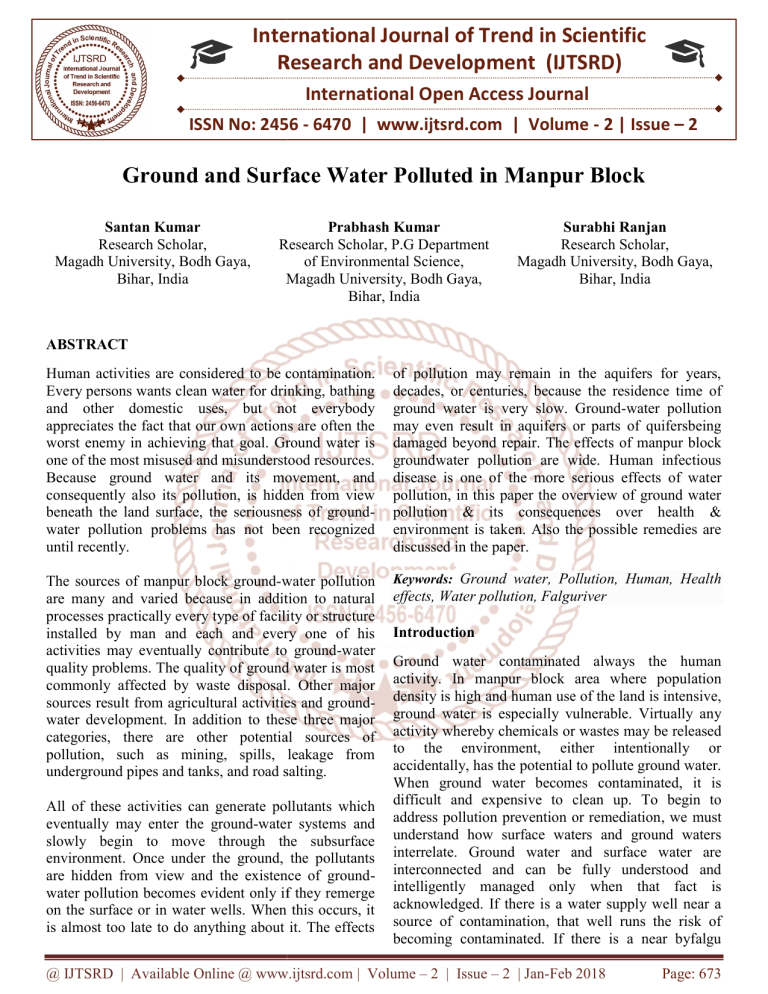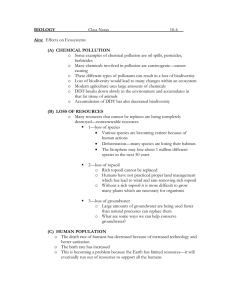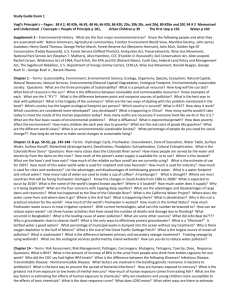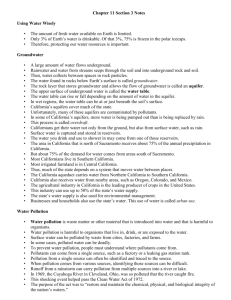
International Journal of Trend in Scientific Research and Development (IJTSRD) International Open Access Journal ISSN No: 2456 - 6470 | www.ijtsrd.com | Volume - 2 | Issue – 2 Ground and nd Surface Water Polluted in n Manpur Block Santan Kumar Research Scholar, Magadh University, Bodh Gaya, Bihar, India Prabhash Kumar Research Scholar, P.G Dep Department of Environmental Science, Magadh University, Bodh Gaya, Bihar, India Surabhi Ranjan Research Scholar, Magadh University, Bodh Gaya, Bihar, India ABSTRACT Human activities are considered to be contaminatio contamination. Every persons wants clean water for drinking, bathing and other domestic uses, but not everybody appreciates the fact that our own actions are often the worst enemy in achieving that goal. Ground water is one of the most misused and misunderstood resources. Because ground water and its movement, and consequently also its pollution, is hidden from view beneath the land surface, the seriousness of ground groundwater pollution problems has not been recognized until recently. of pollution may remain in the aquifers for years, decades, or centuries, because the residence time of ground water is very slow. Ground-water Ground pollution may even result in aquifers or parts of quifersbeing damaged beyond repair. The effects of manpur block groundwater pollution are wide. Human infectious disease is one of the more serious effects of water wat pollution, in this paper the overview of ground water pollution & its consequences over health & environment is taken. Also the possible remedies are discussed in the paper. The sources of manpur block ground-water water pollution are many and varied because in addition to natural processes practically every type of facility or structure installed by man and each and every one of his activities may eventually contribute to ground ground-water quality problems. The quality of ground water is most commonly affected by waste disposal. Other major sources result from agricultural al activities and ground groundwater development. In addition to these three major categories, there are other potential sources of pollution, such as mining, spills, leakage from underground pipes and tanks, and road salting. Keywords: Ground water, Pollution, Human, Health All of these activities can generate pollutants which eventually may enter the ground-water water systems and slowly begin to move through the subsurface environment. Once under the ground, the pollutants are hidden from view and the existence of ground groundwater pollution llution becomes evident only if they remerge on the surface or in water wells. When this occurs, it is almost too late to do anything about it. The effects effects, Water pollution, Falguriver uriver Introduction Ground water contaminated always the human activity. In manpur block area where population density is high and human use of the land is intensive, ground water is especially vulnerable. Virtually any activity whereby chemicals or wastes may be released to the environment, either intentionally or accidentally, has the potential to pollute ground water. When ground water becomes contaminated, it is difficult and expensive to clean up. To begin to address pollution prevention or remediation, remediation we must understand how surface waters and ground waters interrelate. Ground water and surface water are interconnected and can be fully understood and intelligently managed only when that fact is acknowledged. If there is a water supply well near a sourcee of contamination, that well runs the risk of becoming contaminated. If there is a near byfalgu @ IJTSRD | Available Online @ www.ijtsrd.com | Volume – 2 | Issue – 2 | Jan-Feb Feb 2018 Page: 673 International Journal of Trend in Scientific Research and Development (IJTSRD) ISSN: 2456-6470 river or other sources, that water body may also become polluted by the ground water. SOURCES OF CONTAMINATION GROUND WATER In Manpur block area Ground water can become contaminated from natural sources or numerous types of human activities. Residential, municipal, There are many different sources of groundwater contamination. Groundwater becomes contaminated when anthropogenic, or people-created, substances are dissolved or mixed in waters recharging the aquifer. Examples of this are road salt, petroleum products leaking from underground storage tanks, nitrates from the overuse of chemical fertilizers or manure on farmland, excessive applications of chemical pesticides, leaching of fluids from landfills and dumpsites, and accidental spills. Contamination also results from an overabundance of naturally occurring iron, sulphides, manganese, and substances such as arsenic. Excess iron and manganese are the most common natural contaminants. Another form of contamination results from the radioactive decay of uranium in bedrock, which creates the radioactive gas radon. Methane and other gases sometimes cause problems. Seawater can also seep into groundwater and is a common problem in coastal areas. It is referred to as "saltwater intrusion". These contaminants can originate from a “point source” or “non-point source” – meaning they can come from a single source (or point) or, that they don’t have one specific source and come instead from the cumulative effect of any number of factors or activities. commercial, industrial, and agricultural activities can all affect ground water. Contaminants may reach ground water from activities on the land surface, such as releases or spills from stored many industrial wastes; from sources below the land surface but above the water table, such as septic systems or leaking underground oil storage systems; from structures beneath the water table, such as wells; or from contaminated recharge water. Point sources a) On-site septic systems b) Leaky tanks or pipelines containing petroleum products c) Leaks or spills of industrial chemicals at manufacturing facilities d) Underground injection wells (industrial waste) e) Municipal landfills f) Livestock wastes g) Leaky sewer lines h) Chemicals used at wood preservation facilities i) Mill tailings in mining areas j) Fly ash from coal-fired power plants k) Sludge disposal areas at petroleum refineries l) Land spreading of sewage or sewage sludge m) Graveyards n) Road salt storage areas o) Wells for disposal of liquid wastes p) Runoff of salt and other chemicals from roads and highways q) Spills related to highway or railway accidents r) Coal tar at old coal gasification sites Non-point (distributed) sources a) b) c) Fertilizers on agricultural land Pesticides on agricultural land and forests Contaminants in rain, snow, and dry atmospheric fallout @ IJTSRD | Available Online @ www.ijtsrd.com | Volume – 2 | Issue – 2 | Jan-Feb 2018 Page: 674 International Journal of Trend in Scientific Research and Development (IJTSRD) ISSN: 2456-6470 Natural Sources Some substances found naturally in rocks or soils, such as iron, manganese, arsenic, chlorides, fluorides, sulfates, or radioactive elements, can become dissolved in ground water. Other naturally occurring substances, such as decaying organic matter, can move in ground water as particles. The natural arsenic pollution occurs because aquifer sediments contain organic matter that generates anaerobic conditions in the aquifer. These conditions result in the microbial dissolution of iron oxides in the sediment and, thus, the release of the arsenic, normally strongly bound to iron oxides, into the water. As a consequence, arsenic-rich groundwater is often iron-rich, although secondary processes often obscure the association of dissolved arsenic and dissolved iron Whether any of these substances appears in ground water depends on local conditions. Some substances may pose a health threat if consumed in excessive quantities; others may produce an undesirable odour, taste, or colour. Ground water that contains unacceptable concentrations of these substances are not used for drinking water or other domestic water uses unless it is treated to remove these contaminants. The occurrence of fluoride is close related to the abundance and solubility of fluoride-containing minerals such as fluorite (CaF2). Considerably high concentrations of fluoride in groundwater are typically caused by a lack of calcium in the aquifer. Health problems associated with dental fluorosis may occur when fluoride concentrations in groundwater exceed 1.5 mg/l, which is the WHO guideline value since 1984. Septic Systems Onsite wastewater disposal systems used by homes, offices or other buildings that are not connected to a city sewer system. Septic systems are designed to slowly drain away human waste underground at a slow, harmless rate. An improperly designed, located, constructed, or maintained septic system can leak bacteria, viruses, household chemicals, and other contaminants into the groundwater causing serious problems. Improper Disposal of Hazardous Waste In the manpur block, there are thought to be over 10,000 known abandoned and uncontrolled hazardous waste sites and the numbers grow every year. Hazardous waste sites can lead to groundwater contamination if there are barrels or other containers laying around that are full of hazardous materials. If there is a leak, these contaminants can eventually make their way down through the soil and into the groundwater. Many chemicals should not be disposed of in household septic systems, including oils, lawn and garden chemicals, paints and thinners, medicines, photographic chemical, and textiles chemicals. Similarly, many substances used in industrial processes should not disposed of in drains at the workplace because they could contaminate a drinking water source. Industry should trained employees in the proper use and disposal of all chemicals used on site. The many different types and the large quantities of chemicals used at industrial locations make proper disposal of wastes especially important for ground water protection. Releases and Spills from Stored Chemicals and Petroleum Product Underground storage tank are commonly used to store petroleum products and chemicals products. For example, many petroleum departments also store diesel fuel, petrol, kirosin oil or chemicals in on-site tanks. Industries use storage tanks to hold chemicals used in industrial processes or to store hazardous wastes. Many underground storage tanks exist in the manpur, the contents of many of these tanks have leaked and spilled into the environment. An underground storage tank develops a leak, which commonly occurs as the tank ages and corrodes; its contents can migrate through the soil and reach the ground water. Abandoned underground tanks pose another problem because their location is often unknown. Aboveground storage tanks can also pose a threat to ground water if a spill or leak occurs. @ IJTSRD | Available Online @ www.ijtsrd.com | Volume – 2 | Issue – 2 | Jan-Feb 2018 Page: 675 International Journal of Trend in Scientific Research and Development (IJTSRD) ISSN: 2456-6470 Pesticide and Fertilizer Use Many tons of fertilizers and pesticides e.g., herbicides, insecticides, rodenticides, fungicides etcare used annually in manpur block area for crop production. In addition to farmers use these chemicals. A number of these pesticides and fertilizers highly toxic have entered and contaminated ground water following normal, registered use. Some pesticides remain in soil and water for many months to many years. Another potential source of ground water contamination is animal wastes that percolate into the ground from farm wastes should be removed at regular intervals. Landfills Landfills are the places that our garbage is taken to be buried. Landfills are supposed to have a protective bottom layer to prevent contaminants from getting into the water. However, if there is no layer or it is cracked, contaminants from the landfill (car battery acid, paint, household cleaners, etc.) can make their way down into the groundwater. Public health impacts Polluted water is a cause of human disease, misery and death. According to the World Health Organization (WHO), as many as 4 million children die every year as a result of diarrhoea caused by water-borne infection. The bacteria most commonly found in polluted water are coliforms excreted by humans. Surface runoff and consequently non-point source pollution contributes significantly to high level of pathogens in surface water bodies. Improperly designed rural sanitary facilities also contribute to contamination of groundwater. Agricultural pollution is both a direct and indirect cause of human health impacts. The WHO reports that nitrogen levels in groundwater have grown in many parts of the world as a result of "intensification of farming practice" (WHO, 1993). This phenomenon is well known in parts of Europe. Nitrate levels have grown in some countries to the point where more than 10% of the population is exposed to nitrate levels in drinking water that are above the 10 mg/l guideline. Although WHO finds no significant links between nitrate and nitrite and human cancers, the drinking water guideline is established to prevent methaemoglobinaemia to which infants are particularly susceptible (WHO, 1993). @ IJTSRD | Available Online @ www.ijtsrd.com | Volume – 2 | Issue – 2 | Jan-Feb 2018 Page: 676 International Journal of Trend in Scientific Research and Development (IJTSRD) ISSN: 2456-6470 Although the problem is less well documented, nitrogen pollution of groundwater appears also to be a problem in developing countries Microbiological contamination of food crops stemming from use of water polluted by human wastes and runoff from grazing areas and stockyards. This applies both to use of polluted water for irrigation, and by direct contamination of foods by washing vegetables etc. in polluted water prior to sale. In many developing countries there is little or no treatment of municipal sewage, yet urban wastewater is increasingly being used directly or recycled from receiving waters, into irrigated agriculture. The most common diseases associated with contaminated irrigation waters are cholera, typhoid, ascariasis, amoebiasis, giardiasis, and enteroinvasive E. coli. Crops that are most implicated with spread of these diseases are ground crops that are eaten raw such as cabbage, lettuce, strawberries, etc. How to Reduce Ground Water Pollution Groundwater pollution is much more difficult to abate than surface pollution because groundwater can move great distances through unseen aquifers. Non-porous aquifers such as clays partially purify water of bacteria by simple filtration (adsorption and absorption), dilution, and, in some cases, chemical reactions and biological activity; however, in some cases, the pollutants merely transform to soil contaminants. Groundwater that moves through open fractures and caverns is not filtered and can be transported as easily as surface water. In fact, this can be aggravated by the human tendency to use natural sinkholes as dumps in areas of karst topography Using water to remove pollutants from the soil, using chemical and aerial solvents, eliminating pollutants with incineration, helping natural organisms for breaking down atoms of pollutants, adding materials to the soil for protecting it and preventing spread of pollution to the other regions Conclusion and Recommendations Ground Water pollution is a global issue and world community is facing worst results of polluted water. Major sources of water pollution are discharge of domestic and agriculture wastes, population growth, excessive use of pesticides and fertilizers and urbanization. Bacterial, viral and parasitic diseases are spreading through polluted water and affecting human health. It is recommended that there should be proper waste disposal system and waste should be treated before entering in to river. Educational and awareness programs should be organized to control the pollution. References 1. Raju, N.J. (2012) Evaluation of Hydrogeochemical Processes in the Pleistocene Aquifers of Middle Ganga Plain, UttarPradesh, India. Environmental Earth Sciences, 65, 12911308. http://dx.doi.org/10.1007/s12665-011-13771 2. Shukla, U.K. and Raju, N.J. (2008) Migration of the Ganga River and Its Implication on HydroGeological Potential ofVaranasi Area, UP, India. Journal of Earth System Science, 117, 489-498. http://dx.doi.org/10.1007/s12040-008-0048-4 3. Raju, N.J. and Reddy, T.V.K. (2007) Environmental and Urbanization Affect on Groundwater Resources in a PilgrimTown of Tirupati, Andhra Pradesh, South India. Applied Geochemistry, 9, 212-223. 4. Sinha, T.K. (2003) Groundwater Conditions and Its Quality in Varanasi City. Indian Journal of Geomorphology, 8,153-154. 5. APHA (2005) Standard Methods for the Examination of Water and Wastewater. 25th Edition, American Public HealthAssociation, Washington DC. 6. Domenico, P.A. and Schwartz, F.W. (1990) Physical and Chemical Hydrogeology. John Wiley & Sons, New York,824. 7. Piper, A.M. (1953) A Graphic Procedure in the Chemical Interpretation of Water Analysis. US Geological SurveyGroundwater Note, 12. 8. Raju, N.J., Ram, P. and Dey, S. (2009) Groundwater Quality in the Lower Varuna River Basin, Varanasi District, UttarPradesh, India. Journal of the Geological Society of India, 7, 178192. http://dx.doi.org/10.1007/s12040-008-0048-4 9. World Health Organization (1997) Guideline for Drinking Water Quality. 2nd Edition, Vol. 2, WHO, Geneva, Healthcriteria and Other Supporting Information, 940-949. @ IJTSRD | Available Online @ www.ijtsrd.com | Volume – 2 | Issue – 2 | Jan-Feb 2018 Page: 677



